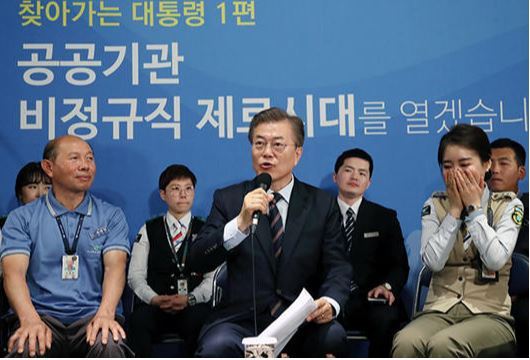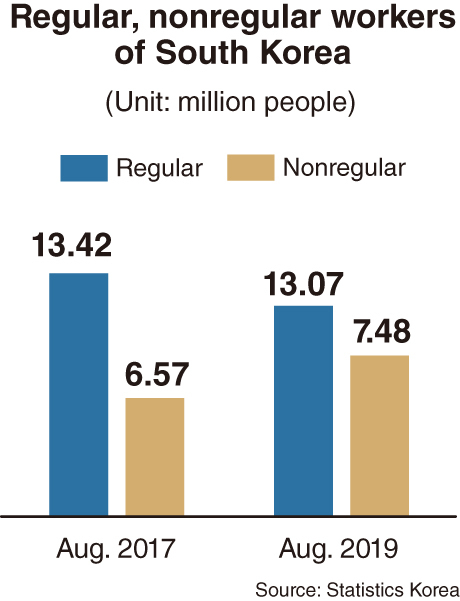[News Focus] Number of nonregular workers up 900,000 during Moon’s term
About 3.3 million Koreans de facto out of work
By Kim Yon-sePublished : Jan. 27, 2020 - 15:11

SEJONG – State employment data showed that job creation under the Moon administration two years has been entirely in nonregular positions.
The number of regular jobs -- positions with permanent contracts and consequently greater protections for workers -- has fallen over the period.
The figures suggest the number of regular workers stayed at a similar level during the first year of President Moon Jae-in’s term -- 13.42 million as of August 2017 and 13.43 million as of August 2018. But it slid to 13.07 million as of August 2019, the most recent month for which Statistics Korea has statistics available.
In contrast, the number of nonregular workers has continued to increase -- 6.57 million as of August 2017, 6.61 million as of August 2018 and 7.48 million as of August 2019. Nonregular workers are those whose contracts finish at a predetermined date.
This data indicates that the number of regular jobs fell by 350,000, while the number of nonregular jobs increased by more than 900,000 over the corresponding two years.
As a result, the proportion of nonregular workers among salaried employees has risen to 36.4 percent, the highest since March 2007, when it reached 36.6 percent.
Though the government agency unveils the relevant data only twice or once (in March or August) per year, the figure stayed under 33 percent between March 2013 and August 2016.
Further, the data was worse for women: Of the total 9.16 million female workers, the number of female nonregular workers came to 4.12 million in August 2019 – 45 percent of the total, the highest since the data was first compiled in August 2003.
The 2019 figure marked a sharp growth from five years earlier, when it stood at 39.9 percent.

As for men, the nonregular-job portion climbed to 29.4 percent as of August 2019, recording the highest in 11 years since the figure reached 30.6 percent in March 2008.
Government officials argued that the 2019 rapid growth in the number of nonregular jobs is due to re-classification of some regular workers totaling about 350,000-500,000 as nonregular workers, mentioning “a new standard” set by the Switzerland-based International Labor Organization. But this -- even if it was true -- cannot justify the nonregular-job increase by 900,000 in two years.
In a similar vein, arguments over South Korea’s official jobless rates have been ceaseless, amid the situation that the government does not include people with nonregular jobs when it counts the official number of jobless.
According to the state-based official data, the number of jobless Koreans was 942,000 as of December 2019 out of the economically active population, 28.09 million.
By this measure, the nation’s unemployment rate was 3.4 percent, and might suggest to some that only 1 out of every 30 Koreans are unemployed.
The official calculation method does not regard “underemployed” people -- who work less than 36 hours a week and want to work more hours, as well as seasonal workers who are out of work for part of the year -- as jobless people.
But the Supplementary Index III for Employment showed that the nation’s de facto jobless rate – including people who consider themselves underemployed and are still looking for work -- reached 11.1 percent as of December.
A research analyst said that “the extended jobless rate of 11.1 percent means that more than 3 million (3.29 million people) out of the economically active population for the age group on an extended basis (29.69 million according to Statistics Korea database) are still looking for jobs.”
Eventually, the extended figure (3.29 million) is higher by 2.34 million than the unemployment statistics (942,000) used by the government in its briefing, and the extended jobless rate is 7.7 percentage points higher than the official rate of 3.4 percent.
Last year, the Washington-based International Monetary Fund pointed out that the Moon administration’s method for calculating the unemployment rate failed to reflect the reality facing job seekers.
A Korean analyst also said the government notify the people of figures based on the Supplementary Index III for Employment in an active manner.
By Kim Yon-se (kys@heraldcorp.com)









![[Kim Seong-kon] Democracy and the future of South Korea](http://res.heraldm.com/phpwas/restmb_idxmake.php?idx=644&simg=/content/image/2024/04/16/20240416050802_0.jpg&u=)









![[Today’s K-pop] Zico drops snippet of collaboration with Jennie](http://res.heraldm.com/phpwas/restmb_idxmake.php?idx=642&simg=/content/image/2024/04/18/20240418050702_0.jpg&u=)